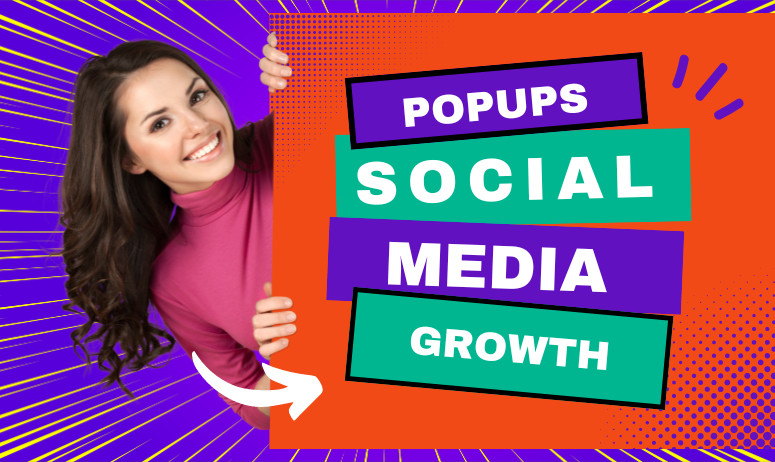Social media is not just an activity; it is an investment of valuable time and resources. Surround yourself with people who not just support you and stay with you, but inform your thinking about ways to WOW your online presence.
Sean Gardner
In today's digital landscape, social media is a driving force for business growth. Whether you’re a startup, an established brand, or a content creator, building a strong social media following can increase your visibility, foster customer loyalty, and amplify your reach. But here's the challenge: growing a social media following is no small feat.
Why Are Popups So Effective for Social Media Growth?
Popups are designed to grab attention without distracting users from their current activities. When used strategically, they encourage visitors to take immediate action, like following your brand on social media. Here’s why they work so well:
Immediate Visibility: Popups naturally draw the eye, making your social media handles or CTAs highly noticeable.
Specific Targeting: You can display your popups to specific users based on behavior, ensuring you reach those most likely to follow you.
User-Friendly Experience: A well-timed popup feels like a helpful suggestion rather than an intrusion.
Understanding Popups and Their Impact on Social Media Growth

Popups are a powerful tool when it comes to growing your social media following. When used strategically, they can grab a visitor’s attention and direct them to take action—whether it’s following your brand on Instagram, liking your Facebook page, or subscribing to your YouTube channel. Let’s dive deeper into how popups can directly affect your social media growth and why they work so well.
How Do Popups Help in Growing Social Media Followers?
Popups work by drawing the visitor’s focus on a specific action. If you want someone to follow your brand on social media, a well-designed popup can make it easier by providing direct access to your social profiles. It eliminates friction like having to search for your brand manually on Instagram or Facebook.
Popups also leverage a sense of urgency or exclusivity. For example, you can design a popup that offers exclusive content or discounts available only to your social media followers. This makes users more likely to engage and hit that follow button.
The Psychology Behind Popup Engagement
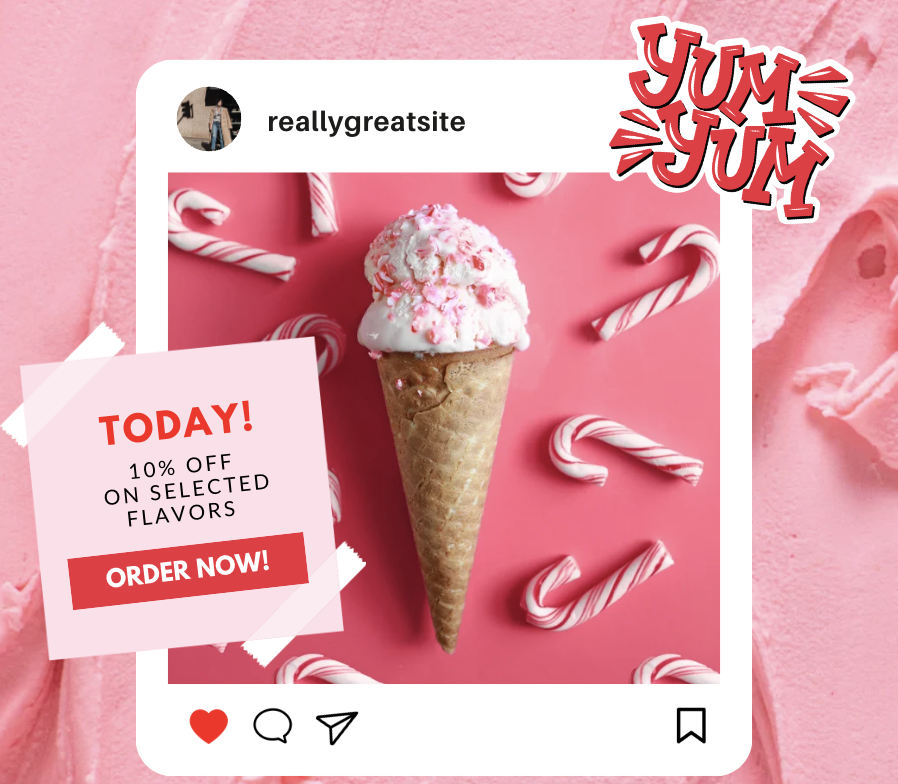
The success of popups lies in human psychology. People respond to clear calls to action, especially when presented in a non-intrusive but engaging way. Here’s how:
Limited Attention Span: A strategically timed popup grabs the user’s attention when they might otherwise overlook social media follow buttons buried in a footer or sidebar.
FOMO (Fear of Missing Out): Popups that highlight limited-time offers or exclusive benefits available only to social media followers tap into users’ fear of missing out.
Social Proof: Including follower counts or testimonials in the popup can boost trust and make users more inclined to follow your brand.
4 Types of Popups for Social Media Growth
There are multiple popup types that you can use to boost your social media following. Each has its specific use case and timing for maximum impact:
Exit-Intent Popups
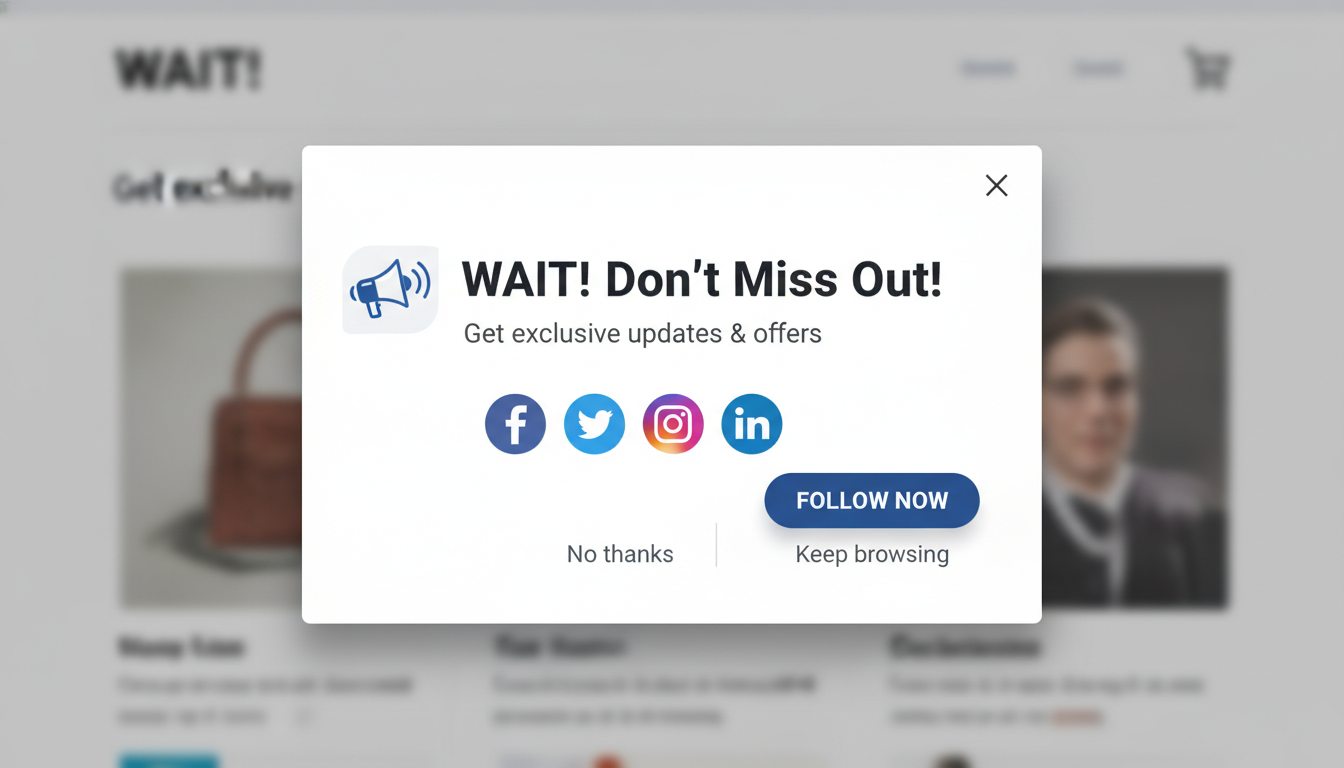
These popups appear when a user is about to leave the website. They can offer a reason to stay engaged by following your brand for future updates.
Scroll-Based Popups

Triggered when a user has scrolled a certain percentage of the page, these popups target engaged visitors who are already consuming your content.
Timed Popups
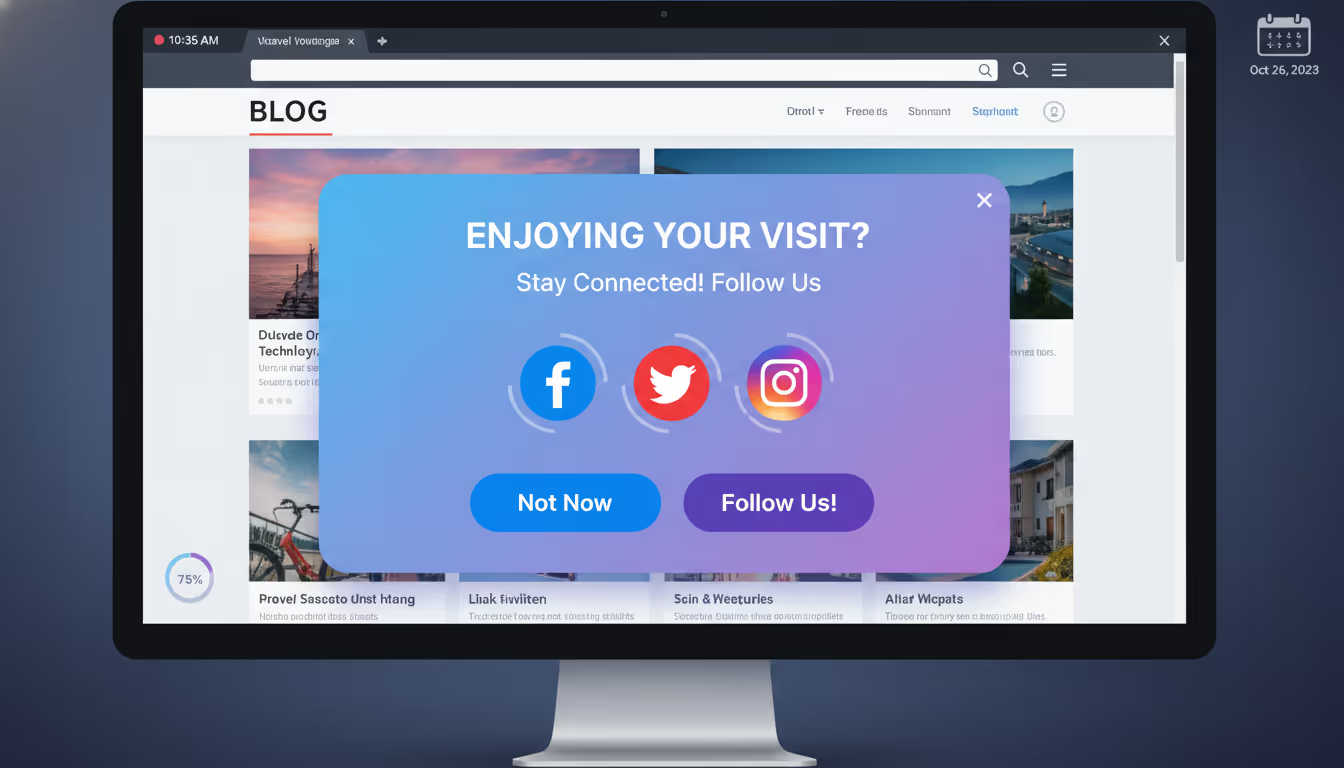
Appearing after a user has spent a specific amount of time on the site, these popups target users who are interested but may need a nudge to follow you on social media.
Trigger-Based Popups
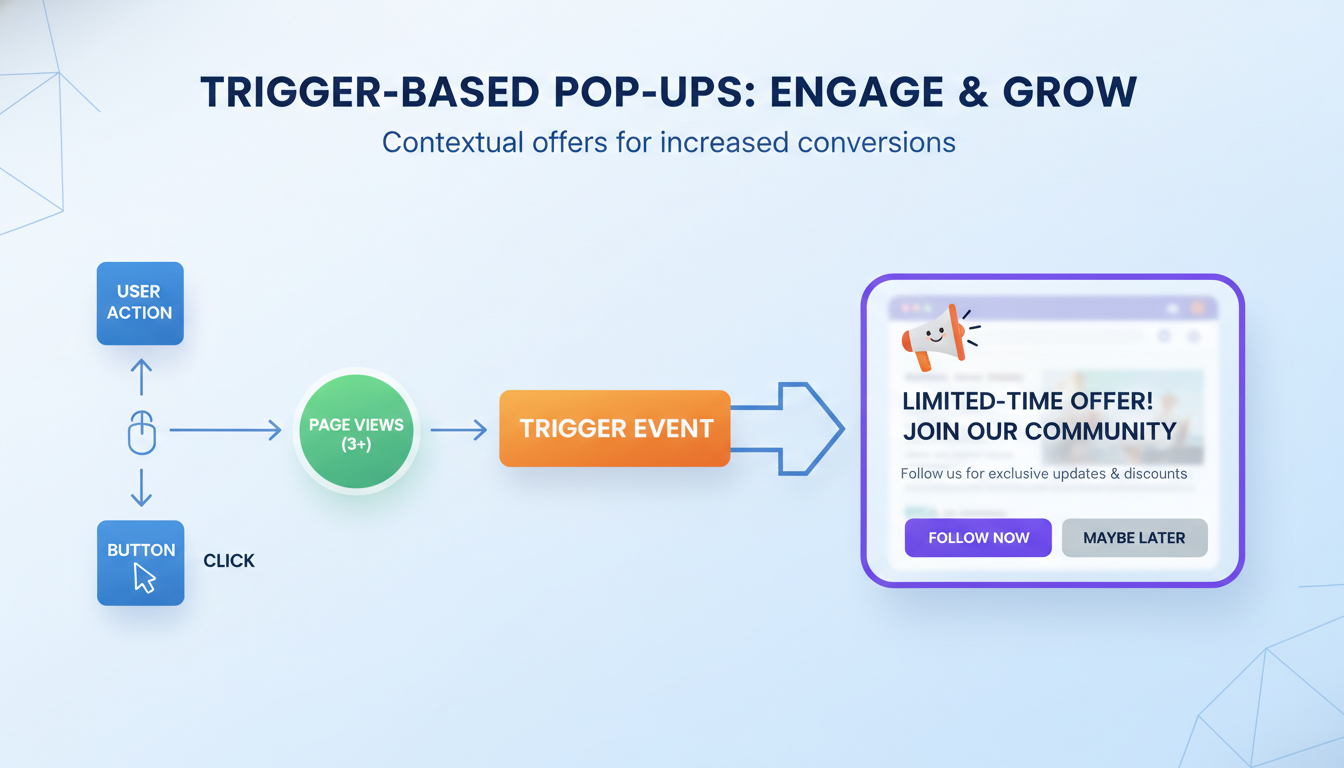
These popups are based on specific actions like clicking a certain button or visiting multiple pages. You can set them to trigger when users engage with your content, offering them a compelling reason to follow you.
Preparing for a Social Media-Focused Popup Campaign
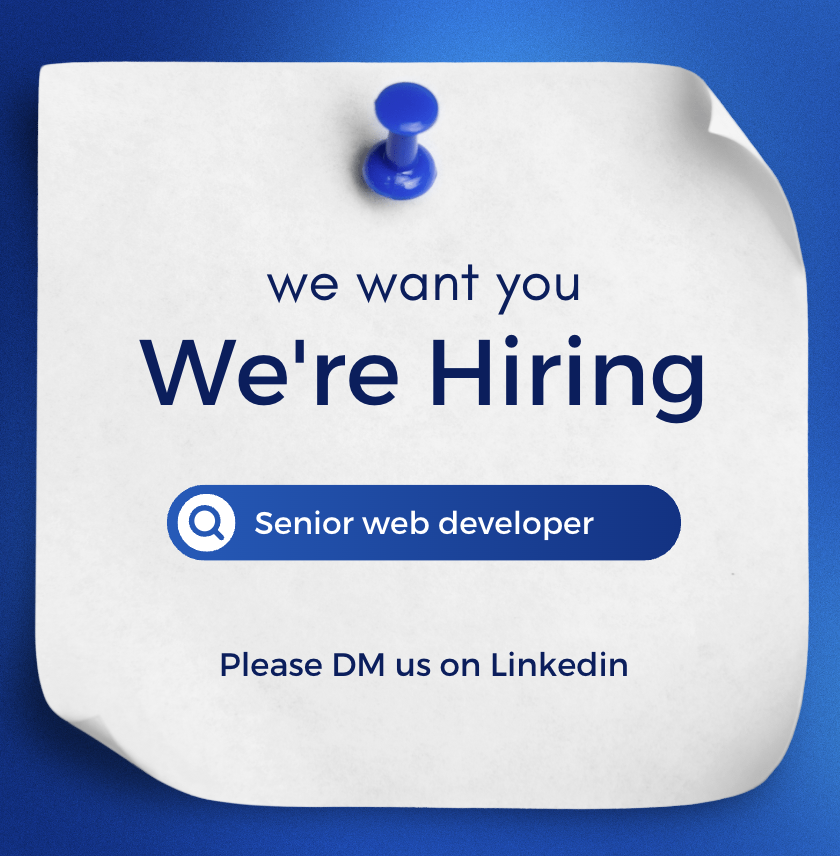
Before diving into creating your popups, it’s essential to lay the groundwork for a successful campaign. A well-prepared strategy ensures that your popups are not only engaging but also targeted toward the right audience with clear goals in mind. Here’s how you can prepare for a social media-focused popup campaign.
Defining Your Social Media Goals
The first step in preparing your campaign is to define what you want to achieve. It’s important to set specific, measurable, achievable, relevant, and time-bound (SMART) goals.
For instance:
Increase Instagram followers by 15% within one month.
Get 500 new likes on Facebook in the next two weeks.
Boost engagement on Twitter by 10% using popup CTAs.
By clearly defining these goals, you can better align your popup design, messaging, and timing to encourage the desired actions.
Identifying Your Target Audience
Your popups should be relevant to the people you want to follow you on social media. Understanding your audience—their demographics, behaviors, and preferences—can significantly boost the effectiveness of your popup campaign.
For instance:
Younger audiences (Gen Z and Millennials) may respond better to popups offering interactive content like quizzes or polls in exchange for social media follows.
Business professionals (LinkedIn users) might be more inclined to follow your brand on social media if the popup promotes industry insights or exclusive business-related updates.
Choosing the Right Social Media Platform to Focus On
Not all platforms will have the same value for every business. Depending on where your audience is most active, you’ll want to focus your popup efforts on the social media platforms that are most relevant to your brand.
If you’re a visually-driven brand, Instagram might be your priority.
For professional services, LinkedIn could be your focus.
If your content is video-heavy, you might want to grow your YouTube channel.
Creating Social Media-Focused Popups Using Poper: Step-by-Step
Now that you’ve got a clear understanding of the best practices for designing popups, it’s time to start creating. Using Poper’s intuitive interface, you can quickly build, customize, and launch your social media-focused popup campaigns. Here’s a step-by-step guide to get you started.
Step 1: Log In to Poper.ai
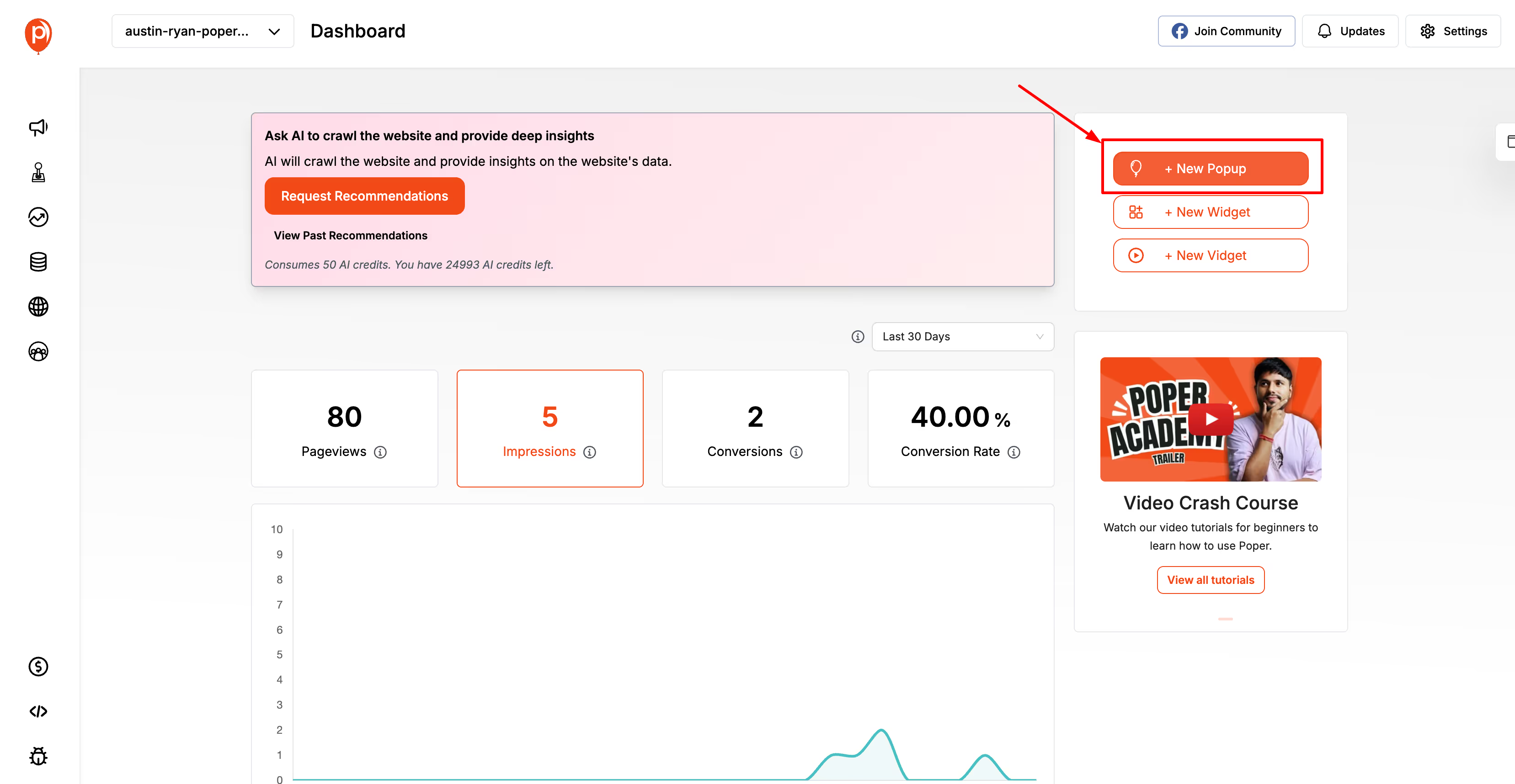
Sign in to your Poper.ai account and open your dashboard. Click “New Popup” to start building a popup specifically geared toward promoting your social media channels.
Step 2: Choose a Template.
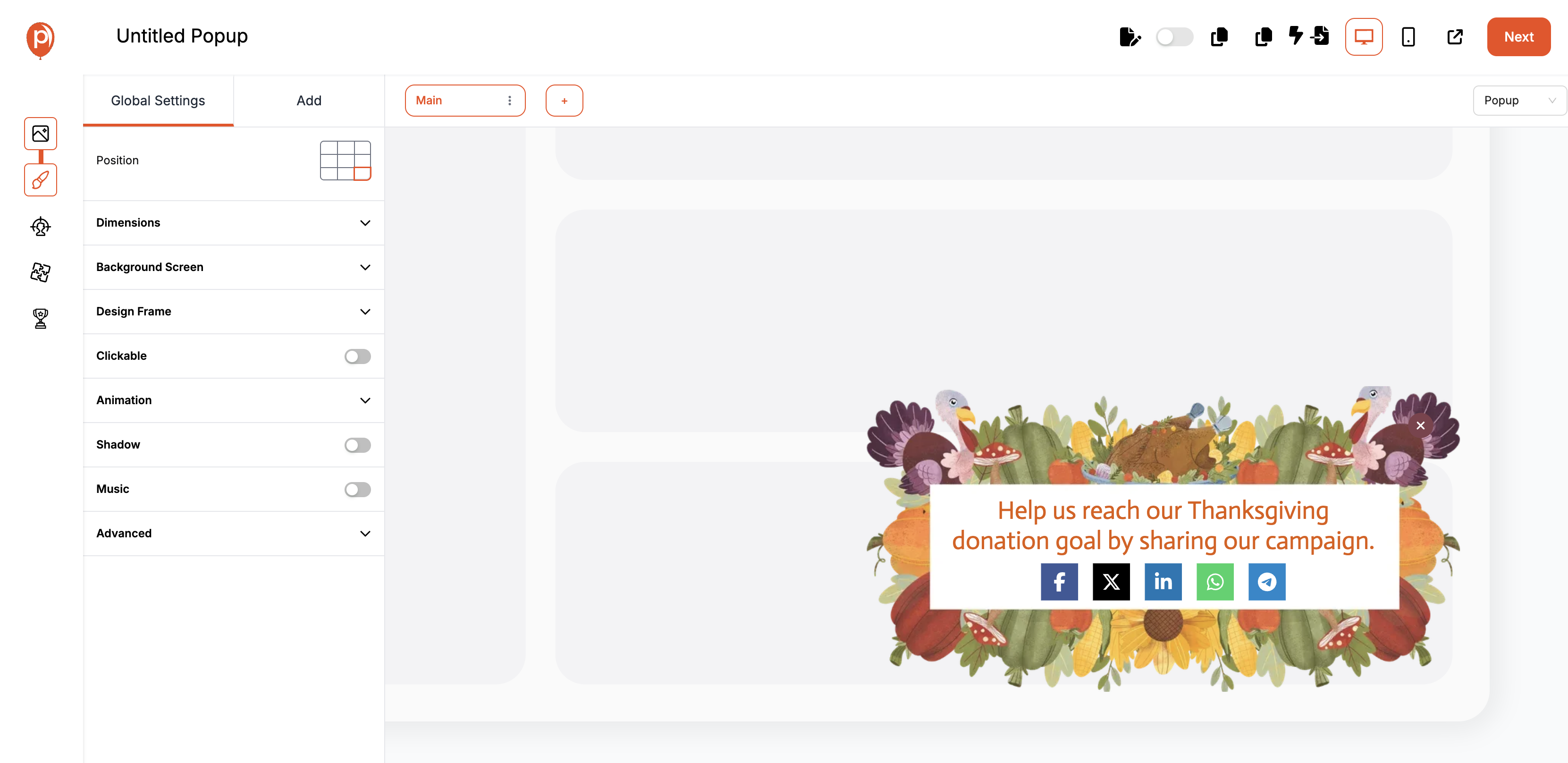
Browse the Social Media and Engagement template. Select a layout designed to highlight your social icons, follower perks, or exclusive community benefits.
Prefer total creative freedom? Start with a blank canvas and design a popup from scratch using Poper’s drag-and-drop builder.
Step 3: Customize the Design
Adjust your popup’s visuals to match your brand and social media aesthetic.
Use bold colors or gradients inspired by your platform of focus (e.g., Instagram-style hues, TikTok neon, YouTube red).
Add recognizable platform icons to instantly show users where you want them to follow you.
Write a clear headline such as “Follow Us for Daily Tips!” or “Join Our Social Community!”
Include supportive text like “Get exclusive content, behind-the-scenes updates, and more.”
Finish with a strong CTA button such as Follow Now, Join the Community, or Connect With Us.
Step 4: Add Interactive Elements
While social follow popups don’t require form fields, you can enhance engagement with interactive widgets:
Add social follow buttons or icon-based links
Include incentive-driven popups (e.g., unlock a free resource after following)
Use gamified elements like spin-the-wheel to encourage participation
These features make visitors more likely to interact instead of simply closing the popup.
Step 5: Personalize the Experience
Use Poper’s AI-powered personalization to match your popup to user behavior and preferences:
Geo-targeting: Promote region-specific social content or accounts
Behavior triggers: Show popups after users read a certain amount of your content, scroll a percentage of the page, or show interest in particular topics
Returning visitor logic: Display different follow prompts to new vs. returning users
This level of personalization increases the chances of genuine social engagement.
Step 6: Configure Display Rules
Decide when, where, and how your social growth popup appears:
Timing triggers: page load, scroll depth, timed delay, or exit intent
Page targeting: show on blog posts related to social content, your homepage, or resource pages
Frequency control: prevent overshowing by limiting display to once per session or once every few days
Smart rules help your popup feel helpful—not intrusive.
Step 7: Publish and Track Performance
Once satisfied, click Publish.
Use Poper.ai’s analytics dashboard to monitor:
Impressions
Click-through rates
Social follow conversions
Engagement insights over time
Step 8: A/B Test
Use Poper’s preview feature to check your popup on both desktop and mobile, ensuring your social icons display cleanly and your CTA is easy to tap.
Run A/B tests comparing:
Popups with different social platforms emphasized
Variations of text, color themes, or incentives
Icon layouts or animation styles
These tests reveal what drives the most follows from your audience.
Keep iterating to continually grow your social presence more effectively.
Implementing Popups for Different Social Media Platforms
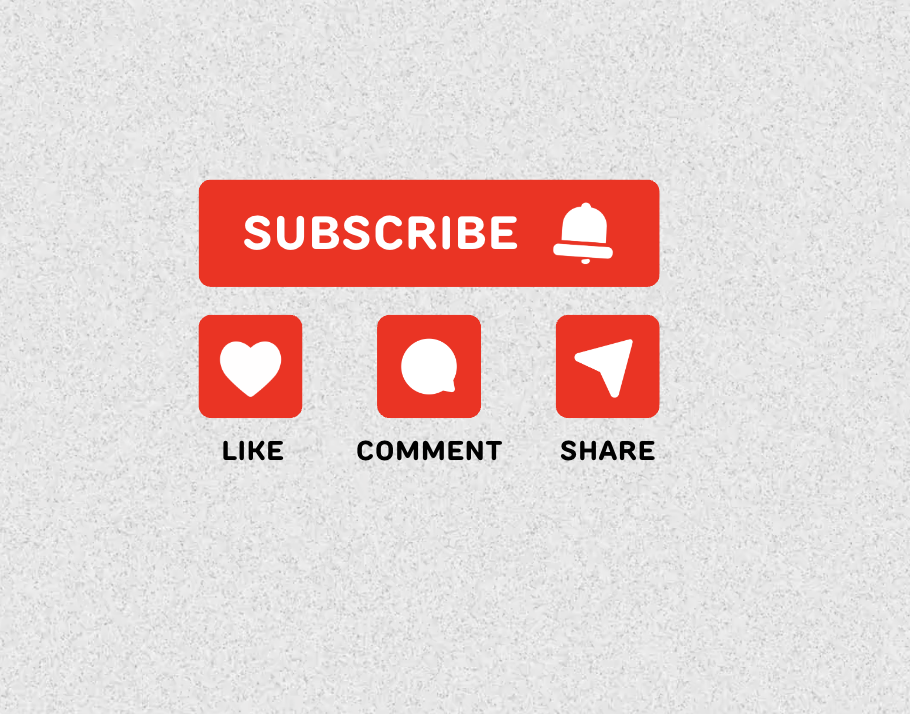
To maximize the potential of your popups, it’s crucial to tailor them according to the platform you are targeting. Different social media platforms offer unique opportunities for engagement, and your popups should reflect this by delivering platform-specific messages and calls to action.
Growing Your Instagram Followers with Popups
Instagram thrives on visual content, and popups promoting your Instagram page should emphasize this. Use stunning visuals, photos, or videos within the popup to entice users to follow your account. The key here is to make your popup visually compelling, just like the platform itself.
Using Popups to Boost Facebook Page Likes
With Facebook’s diverse audience, popups targeting this platform should focus on fostering community and interaction. Highlight the benefits of joining your Facebook page, such as receiving updates, participating in discussions, or accessing exclusive offers.
Driving Twitter Engagement Through Popups
Twitter is all about quick, engaging content, so your popup should reflect that by being short, snappy, and direct. Focus on offering exclusive content, such as insights or real-time updates, to encourage users to follow you.
Increasing LinkedIn Connections with Targeted Popups
LinkedIn is all about professional growth and networking, so your popups for this platform should appeal to users who want to connect for business or career opportunities. Focus on promoting your brand’s industry expertise, thought leadership, or networking opportunities.
Using Popups to Promote TikTok or YouTube Channels
For platforms like TikTok and YouTube, where video content is key, your popups should entice visitors with exclusive access to engaging, visual content. Whether you’re showcasing tutorials, behind-the-scenes clips, or entertainment content, the popup should focus on the type of videos they’ll gain access to by following you.
How Poper Integrates Seamlessly with Social Media Platforms
Poper’s strength lies in its ability to integrate seamlessly with various social media platforms, allowing you to create dynamic and engaging popups that connect directly with your social profiles.
Key Integration Features:
Direct social media linking: Add direct links to your social media profiles in the CTA buttons, so visitors can quickly follow or like your page.
Auto-fill features: Allow users to easily engage without manually entering their information.
A/B testing: Run different popup campaigns across various platforms and track which social media popup design and CTA resonates best with your audience.
Timing and Placement of Popups for Maximum Effect
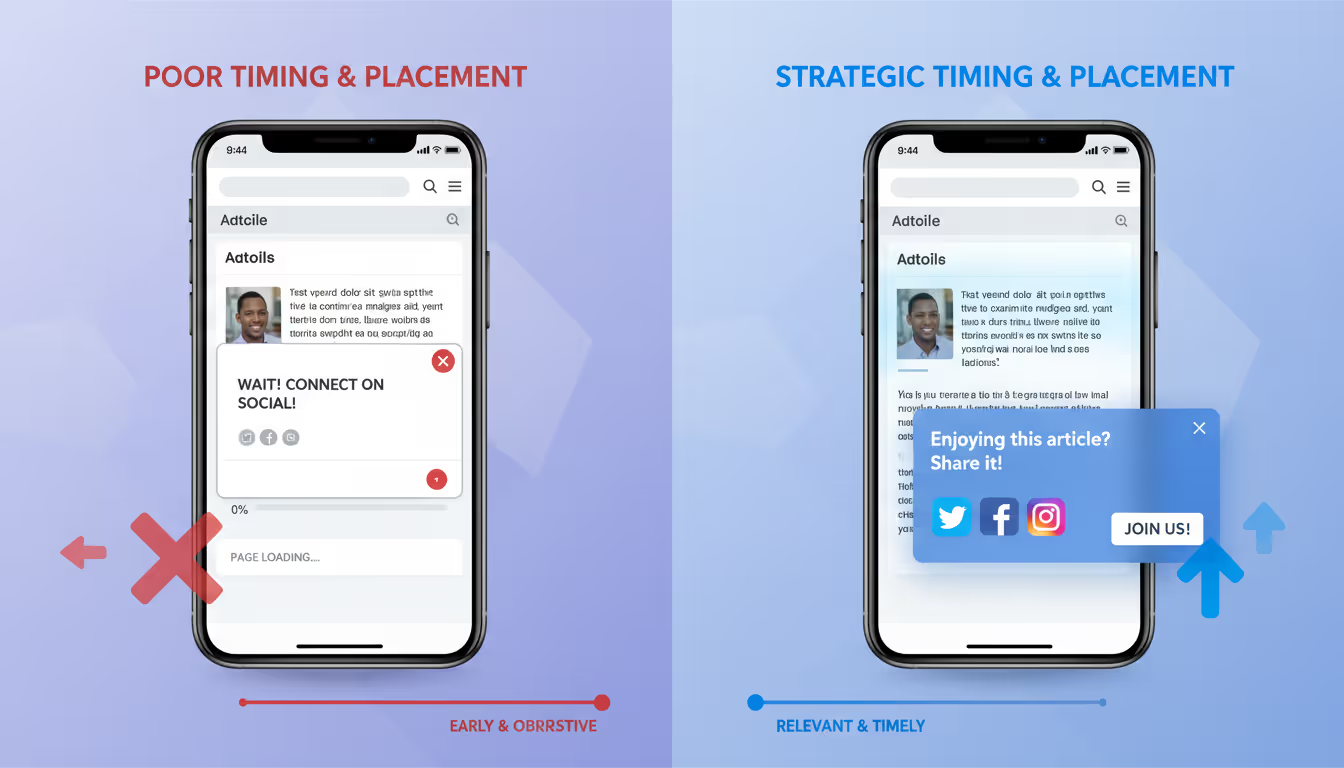
Timing and placement are essential to the success of any popup campaign, particularly when your goal is to increase social media engagement. Poorly timed or improperly placed popups can irritate users, causing them to leave your site or ignore your message. On the other hand, strategic timing and placement can significantly improve engagement and conversions.
When Should You Display Popups to Maximize Impact?
Timing is everything when it comes to popups. The goal is to capture the visitor’s attention without being intrusive.
Best Timing Strategies:
Exit-Intent Popups: Display popups just as the user is about to leave your website, giving them one last opportunity to engage.
Scroll-Triggered Popups: Show popups after a visitor scrolls a certain percentage of the page, indicating they’re already engaged with the content.
Time-Delayed Popups: Wait for users to spend a specific amount of time on your site before displaying a popup. This ensures they’re interested in your content and more likely to engage.
Where to Place Popups on Your Website for the Best Engagement
Proper placement of popups is crucial for not disrupting the user experience while still making the popup noticeable.
Effective Popup Placement Strategies:
Center of the screen: Great for attention-grabbing messages, but use sparingly to avoid disrupting the user experience.
Sidebar or bottom corner: These locations are less intrusive but still visible, making them ideal for ongoing social media prompts.
After content blocks: This can be a more natural placement that doesn’t interrupt the visitor’s reading experience but still draws attention.
Iterating and Scaling Your Popup Campaigns

Once you’ve analyzed your initial results, it’s time to refine and scale your campaigns to ensure ongoing success. Continuous iteration is key to maximizing conversions and keeping your strategies relevant.
Iterative Improvements:
Refine Based on Data: Use the insights gathered from your analytics to tweak and improve your popups. Focus on elements that drive the most engagement and eliminate or adjust those that underperform.
Expand to New Platforms: After finding success with one social media platform, replicate the strategy for other platforms, customizing the approach based on each one’s unique audience.
Leverage Seasonal Campaigns: Time your popup campaigns around holidays, sales events, or product launches to capture the increased traffic and engagement.
Scaling Up:
Run Multiple Campaigns Simultaneously: With Poper’s easy-to-use interface, you can create and manage multiple popup campaigns targeting different audience segments or platforms.
Track Performance Across Different Channels: Use the analytics dashboard to compare how your popups are performing across different social media platforms. This will help you identify where to allocate more resources.
Automate Processes: Poper offers automation features that allow you to set up triggers and rules, so your popups display at the right time without manual intervention.
Maintaining Long-Term Success with Social Media Popups
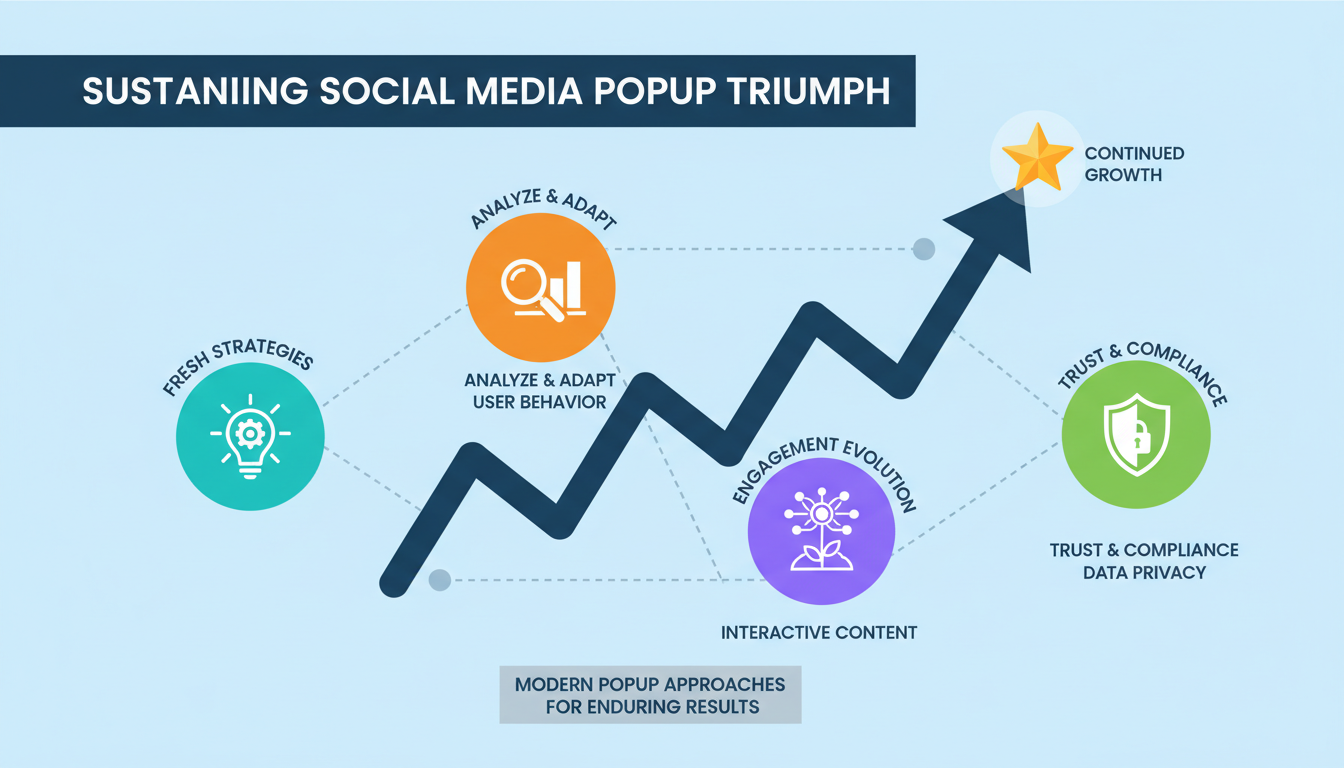
After you’ve gained initial traction, it's crucial to keep your popup strategies fresh and adaptable to ensure continued growth and engagement. Below are some approaches to help you maintain and expand your success over time.
Regularly Update Content and Offers
Popups should stay relevant to current trends, campaigns, and user interests. Outdated messages or visuals can lead to user fatigue and reduced engagement. Keep your content dynamic by:
Seasonal Updates: Adjust your popups to align with holidays, seasonal sales, or new product launches.
New Offers and Promotions: Regularly rotate promotional offers or discounts to keep users excited and incentivized.
Content Refresh: If promoting content like blogs or articles, ensure the information being highlighted is up-to-date and relevant to current audience interests.
Retargeting Campaigns
Implement retargeting popups for users who have visited your site but haven’t yet followed your social media or completed a specific action. Poper allows you to create campaigns based on previous user behavior, helping you reconnect with visitors and drive conversions.
Effective Retargeting Strategies:
Engagement-Based Popups: Show specific popups to users who have engaged with your content but haven’t followed your social media yet. For instance, offer exclusive content or discounts to re-engage them.
Abandoned Cart Recovery: For e-commerce sites, use popups to remind users about their abandoned cart and offer them a discount if they follow you on social media.
Exit-Intent Retargeting: Show a popup with a strong incentive (like an exclusive offer) just before users are about to leave your site, encouraging them to follow your brand on social media.
Explore New Popup Types to Keep Engagement High
Diversifying the types of popups you use can help maintain user interest and prevent popup fatigue. Poper offers several unique popup types that can be customized for social media engagement:
Video Popups
Engage visitors with video popups that promote your social media content. Video is highly engaging and allows you to showcase dynamic content such as behind-the-scenes footage, product demos, or testimonials.
Gamified Popups
Increase engagement with gamified popups, such as spin-the-wheel or scratch-and-win popups, where users can follow your social media to participate in fun games with rewards.
Survey or Feedback Popups
Use survey popups to ask users for feedback on their experience or preferences. In exchange for their input, offer an incentive to follow your social media channels. This can help improve your site while boosting engagement.
FAQs
What Are the Best Popup Tools for Growing Social Media Followers?
There are several popup tools available, but Poper stands out with its ease of use, pre-built templates, and advanced analytics features, making it ideal for both beginners and experienced marketers.
How Can I Avoid Being Too Intrusive with Popups?
Ensure your popups are timed well—like using exit-intent or scroll-based popups—and don’t overwhelm users with too many popups. Poper’s smart triggers allow you to adjust popup frequency and timing to maintain a balance between engagement and user experience.
What Should I Do if My Popups Aren’t Converting as Expected?
Use Poper’s A/B testing feature to experiment with different designs, messaging, and CTAs. Analyze the data in Poper’s analytics dashboard to identify areas for improvement.
Can Popups Work for Small Businesses Looking to Grow Social Media?
Yes, small businesses can greatly benefit from popups. Poper’s affordable plans and simple design tools make it easy for small businesses to create effective popups without a large marketing budget.
How Does Poper Make Popup Creation and Management Easier?
Poper offers a drag-and-drop interface, pre-designed templates, and customizable triggers that simplify the entire process of creating, launching, and managing popups. With built-in analytics, you can also track performance and make data-driven decisions to improve results.
Conclusion
Popups, when designed and timed effectively, can be a game-changing tool for growing your social media following. From leveraging incentives to creating dynamic, personalized messages, the right popup strategy can enhance your social media presence while engaging your website visitors in a non-intrusive manner.


